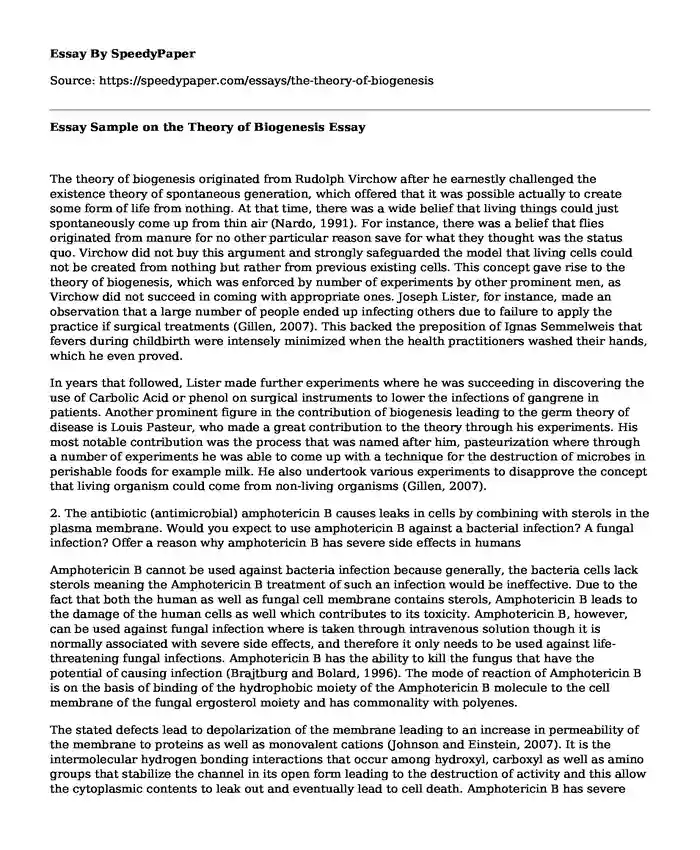The theory of biogenesis originated from Rudolph Virchow after he earnestly challenged the existence theory of spontaneous generation, which offered that it was possible actually to create some form of life from nothing. At that time, there was a wide belief that living things could just spontaneously come up from thin air (Nardo, 1991). For instance, there was a belief that flies originated from manure for no other particular reason save for what they thought was the status quo. Virchow did not buy this argument and strongly safeguarded the model that living cells could not be created from nothing but rather from previous existing cells. This concept gave rise to the theory of biogenesis, which was enforced by number of experiments by other prominent men, as Virchow did not succeed in coming with appropriate ones. Joseph Lister, for instance, made an observation that a large number of people ended up infecting others due to failure to apply the practice if surgical treatments (Gillen, 2007). This backed the preposition of Ignas Semmelweis that fevers during childbirth were intensely minimized when the health practitioners washed their hands, which he even proved.
In years that followed, Lister made further experiments where he was succeeding in discovering the use of Carbolic Acid or phenol on surgical instruments to lower the infections of gangrene in patients. Another prominent figure in the contribution of biogenesis leading to the germ theory of disease is Louis Pasteur, who made a great contribution to the theory through his experiments. His most notable contribution was the process that was named after him, pasteurization where through a number of experiments he was able to come up with a technique for the destruction of microbes in perishable foods for example milk. He also undertook various experiments to disapprove the concept that living organism could come from non-living organisms (Gillen, 2007).
2. The antibiotic (antimicrobial) amphotericin B causes leaks in cells by combining with sterols in the plasma membrane. Would you expect to use amphotericin B against a bacterial infection? A fungal infection? Offer a reason why amphotericin B has severe side effects in humans
Amphotericin B cannot be used against bacteria infection because generally, the bacteria cells lack sterols meaning the Amphotericin B treatment of such an infection would be ineffective. Due to the fact that both the human as well as fungal cell membrane contains sterols, Amphotericin B leads to the damage of the human cells as well which contributes to its toxicity. Amphotericin B, however, can be used against fungal infection where is taken through intravenous solution though it is normally associated with severe side effects, and therefore it only needs to be used against life-threatening fungal infections. Amphotericin B has the ability to kill the fungus that have the potential of causing infection (Brajtburg and Bolard, 1996). The mode of reaction of Amphotericin B is on the basis of binding of the hydrophobic moiety of the Amphotericin B molecule to the cell membrane of the fungal ergosterol moiety and has commonality with polyenes.
The stated defects lead to depolarization of the membrane leading to an increase in permeability of the membrane to proteins as well as monovalent cations (Johnson and Einstein, 2007). It is the intermolecular hydrogen bonding interactions that occur among hydroxyl, carboxyl as well as amino groups that stabilize the channel in its open form leading to the destruction of activity and this allow the cytoplasmic contents to leak out and eventually lead to cell death. Amphotericin B has severe side effects in humans due to the fact that both the human as well as fungal cell membrane contains sterols and thus Amphotericin B leads to the damage of the human cells as well which contributes to its toxicity. The side effects may also be caused by histamine liberation or due to an increase in prostaglandin synthesis (Brajtburg and Bolard, 1996).
References
Brajtburg J, Bolard J. Carrier effects on biological activity of Amphotericin B. Clin Microbiol Rev. 1996;9:51231.
Johnson RH, Einstein HE. Amphotericin B and coccidioidomicosis. Ann NY Acad Sci. 2007;1111:43441.
Nardo, Don. Germs: Mysterious Microorganisms. San Diego, CA: Lucent Books, 1991. Print.
Gillen, Alan L. The Genesis of Germs: The Origin of Diseases & the Coming Plagues. Green Forest, AR: Master Books, 2007. Print.
Cite this page
Essay Sample on the Theory of Biogenesis. (2019, May 16). Retrieved from https://speedypaper.net/essays/the-theory-of-biogenesis
Request Removal
If you are the original author of this essay and no longer wish to have it published on the SpeedyPaper website, please click below to request its removal:
- Essay Sample on Why Black Neo-Conservatives Matter
- A Metamorphosis to Adulthood in The Catcher in the Rye. A Literary Essay Sample.
- Business Essay Sample: The Decisions Soraya Needs to Make
- Philosophy Essay Sample: The Illusion of Free Will
- Essay Sample about Internship at Stuart Skin Care Company
- Essay Sample Considering College Student-Athletes
- Free Essay Sample: Gender Identity and Roles in The Yellow Wallpaper
Popular categories





